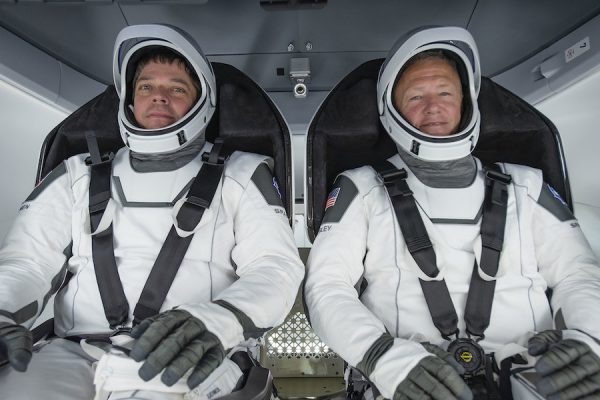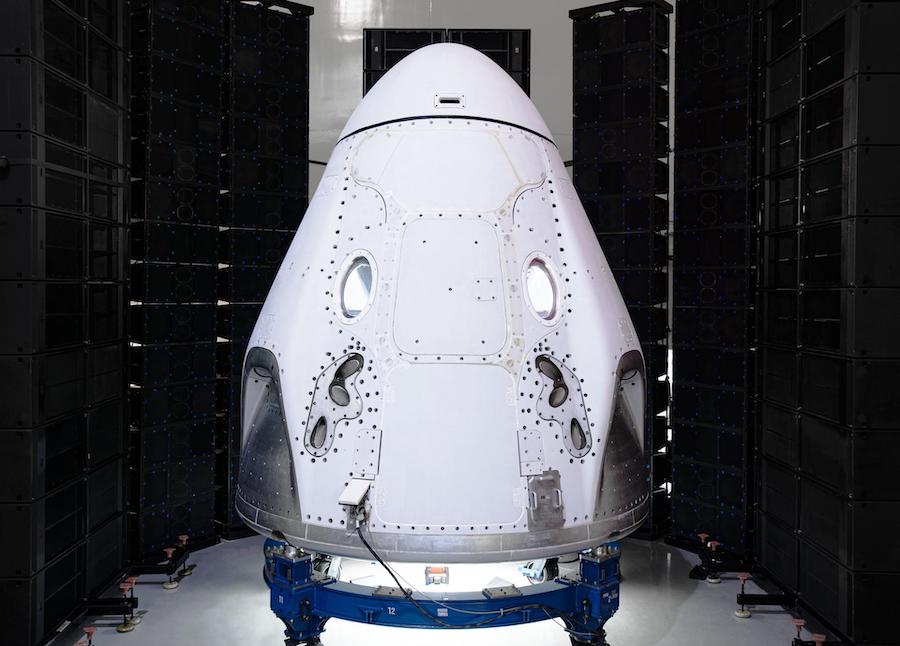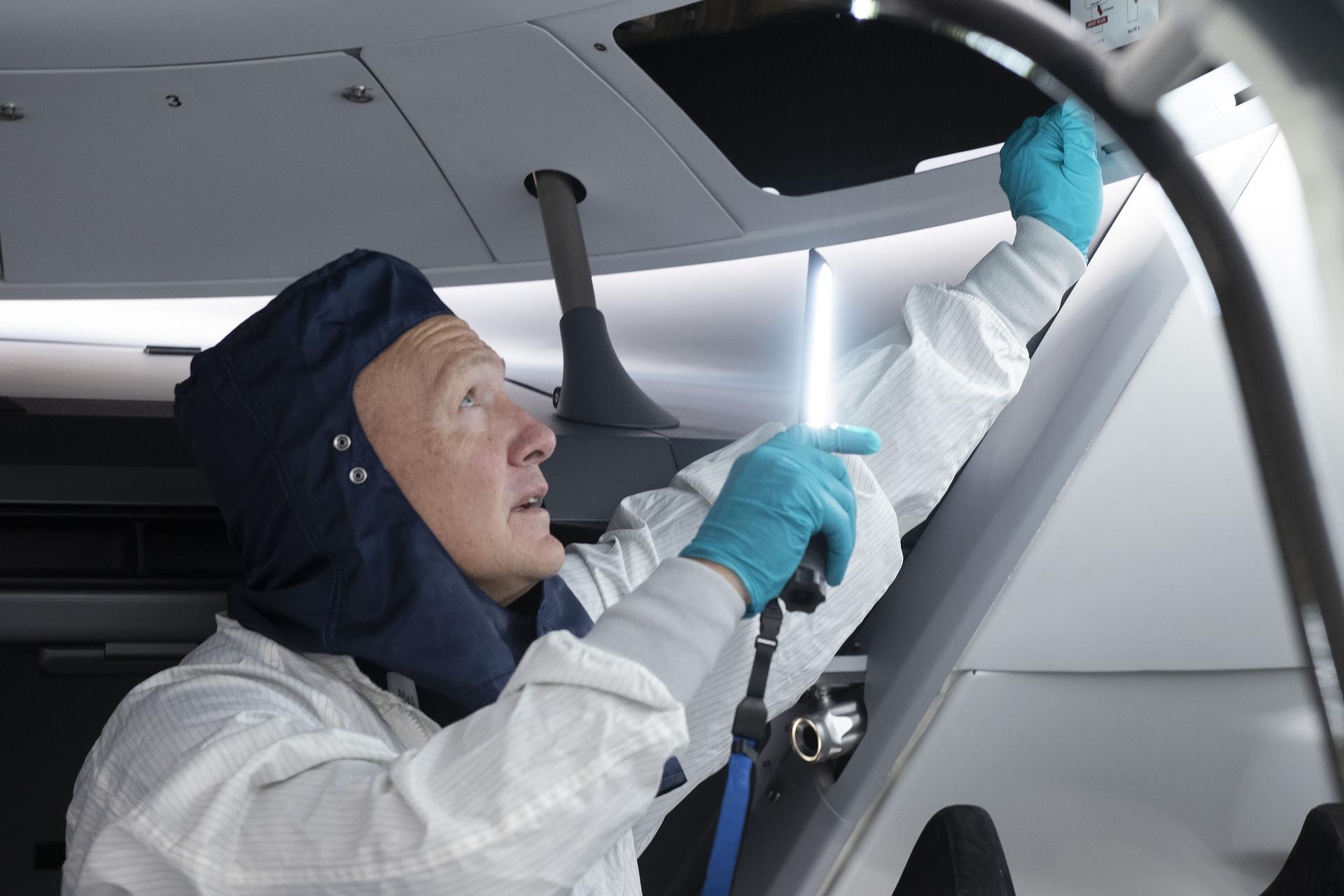Crew training continues for SpaceX’s first launch with astronauts – Spaceflight Now

During a visit to Cape Canaveral this week, NASA astronauts Doug Hurley and Bob Behnken strapped in to the SpaceX crew capsule they will ride into orbit as soon as mid-to-late May. Next week, the astronauts will be in Houston to continue training for an extended stay on the International Space Station that could last two-to-three months.
The two-man team is continuing with their training amid the coronavirus pandemic. Their launch remains scheduled for mid-to-late May, although the schedule could slip amid uncertainties about future impacts from the virus, upcoming parachute testing and an investigation into an engine failure on the most recent SpaceX launch.
Hurley and Behnken were at Cape Canaveral this week, where they crawled inside the Crew Dragon spaceship they will fly into space later this year on the Demo-2 mission, SpaceX’s first mission to carry astronauts.
The event, known as a Crew Equipment Interface Test, or CEIT, allowed the astronauts to get hands-on experience with the hardware they will use during their flight to the space station. Pictures released by NASA showed Hurley and Behnken strapped into their seats inside the Crew Dragon spacecraft, which is being readied for launch in a clean room processing facility at Cape Canaveral Air Force Station.
NASA said the CEIT also “included flight suit leak checks, spacecraft sound verification, display panel and cargo bin inspections, seat hardware rotations, and more.”
Brandi Dean, a NASA spokesperson at the Johnson Space Center in Houston, said Hurley and Behnken also participated in launch pad egress training this week.
Next week, the Demo-2 crew’s jam-packed training schedule continues in Houston, where Hurley and Behnken will participate in space station systems training. Their training next week will also include resizing of spacesuits they would use if they needed to perform a spacewalk outside the space station, Dean said.
There is also an integrated launch simulation planned with the Demo-2 crew next week, Dean told Spaceflight Now.
Hurley and Behnken are shuttling between Florida, Texas and California during their busy training schedule.

Citing NASA Administrator Jim Bridenstine, CNBC reported Friday that preparations for the Demo-2 mission remain on track for launch in mid-to-late May. Bridenstine told CNBC that NASA and SpaceX feel “pretty confident” the launch will occur with a major delay.
“We’re working through the coronavirus pandemic,” Bridenstine told CNBC. “We don’t know what the outcome is going to be … But if it gets delayed a little bit, we’re going to be OK with that.”
Pandemic aside, Bridenstine said NASA and SpaceX are working to close out several issues before the Demo-2 launch.
He told CNBC he feels “really good” about the progress of SpaceX’s testing of the Crew Dragon’s main parachutes. The latest parachute design, named the Mark 3, had completed 24 tests to certify the chutes before a test anomaly March 24 that officials have attributed to the test rig, and not the parachutes themselves.
“The test requires a helicopter to lift the device suspended underneath it to reach the needed test parameters,” NASA said in a 26 statement. “However, the pilot proactively dropped the device in an abundance of caution to protect the test crew as the test device became unstable underneath the helicopter. At the time of the release, the testing device was not armed, and a test of the parachute design was not performed.”
Bridenstine told CNBC said SpaceX plans to perform two more parachute tests using a fixed-wing C-130 cargo plane, rather than a helicopter.
SpaceX is also wrapping up testing of the Crew Dragon’s launch escape system. The company accomplished a successful in-flight escape test in January after a Falcon 9 launch from the Kennedy Space Center.
Ground testing of the Crew Dragon’s modified escape system, which would use eight powerful SuperDraco rockets to push the capsule away from a failing launch vehicle, is nearing completion at NASA’s White Sands Test Facility in New Mexico, according to Bridenstine.
And NASA has joined an investigation into an engine failure on SpaceX’s most recent launch March 18, when one of the nine Merlin 1D engines on the first stage of a Falcon 9 rocket shut down prematurely. The rocket was able to compensate for the early engine shutdown and still delivered 60 more SpaceX Starlink Internet satellites to orbit.
The engine failure occurred on a reused Falcon 9 first stage that was flying for the fifth time. Bridenstine told CNBC he does not expect the engine issue to be a showstopper, and noted that the Demo-2 launch will utilize a brand new Falcon 9 booster.
Bridenstine told CNBC that NASA expects Hurley and Behnken to remain aboard the space station for two-to-three months, depending on when the Demo-2 mission takes off. The test flight was originally scheduled to last a matter of days or weeks, but NASA is keen on extending the mission to give the space station additional manpower during a period when the complex will be staffed with just three crew members, down from the typical six-person crew.
If the Demo-2 mission takes off in May, Hurley and Behnken could return to Earth later in the summer. The first in a series of Crew Dragon missions to ferry operational crews to the space station could blast off as soon as late July with a four-person team of astronauts.
Space station operations are continuing with little impact from the coronavirus pandemic. NASA’s space station control center in Houston is fully staffed, and NASA has said preparations for upcoming crew and cargo missions are receiving high priority, even as some other agency projects experience work stoppages and delays due to restrictions associated with the pandemic.
Dean said NASA is still assessing possible impacts to the Demo-2 crew training schedule if the agency’s human spaceflight centers in Texas and Florida are elevated to Stage 4 of NASA’s coronavirus response framework. Johnson and Kennedy are currently at Stage 3, restricting access to the centers only to “mission-essential” personnel, which include workers needed to support spaceflight hardware, astronaut training and mission operations.
Under the restrictions of a Stage 4 response, NASA says all personnel would be required to telework except those necessary to “protect life and critical infrastructure.” However, NASA has already confirmed there will be some carveouts to that policy to permit space station flight controllers to come to work, and to allow continued preparations for the launch of the Perseverance Mars rover in July.
“Center and agency leadership will provide guidance on specific activities if Kennedy or Johnson goes to Stage 4, including a mission-essential activities list,” Dean said. “Decisions on that list are not yet final, so as to allow leadership maximum flexibility to respond to this rapidly evolving situation.”

NASA says it is following recommendations from the Centers for Disease Control and Prevention.
“Astronaut trainers, along with all NASA employees, are closely adhering to CDC recommendations on infection control for the coronavirus,” NASA said. “As all NASA centers are currently operating in a mode that requires any non-mission-essential work to be done remotely, the number of employees in contact with the crew is limited.”
On March 19 and 20, Hurley and Behnken joined SpaceX and NASA flight controllers to simulate activities they will execute from the Falcon 9 countdown through the Crew Dragon’s launch and docking with the space station.
The astronauts participated inside a SpaceX flight simulator, while SpaceX controllers joined the simulation from a launch control center at the Kennedy Space Center and the Dragon operations facility at the company’s headquarters in Hawthorne, California. NASA teams responsible for the operations of the space station participated from the Johnson Space Center in Houston.
“The simulations were a great opportunity to practice procedures and to coordinate decision-making for the mission management team, especially with respect to weather,” said Michael Hess, manager of operations integration for NASA’s commercial crew program. “Simulation supervisors do a great job at picking cases that really make the team think and discuss.”
The astronauts also completed simulations running from hatch closure through unlocking with the space station, and practiced procedures they will execute during the free flight phase of the mission in preparation for re-entry and splashdown.
Hurley, who piloted two space shuttle missions, will command the Demo-2 test flight. Behnken is a veteran spacewalker who also flew on two shuttle missions.
Email the author.
Follow Stephen Clark on Twitter: @StephenClark1.






